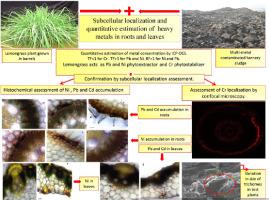当前位置:
X-MOL 学术
›
S. Afr. J. Bot.
›
论文详情
Our official English website, www.x-mol.net, welcomes your feedback! (Note: you will need to create a separate account there.)
Sub-cellular localization and quantitative estimation of heavy metals in lemongrass plants grown in multi-metal contaminated tannery sludge
South African Journal of Botany ( IF 3.1 ) Pub Date : 2020-07-01 , DOI: 10.1016/j.sajb.2020.01.034 Janhvi Pandey , Sougata Sarkar , Rajesh Kumar Verma , Saudan Singh
South African Journal of Botany ( IF 3.1 ) Pub Date : 2020-07-01 , DOI: 10.1016/j.sajb.2020.01.034 Janhvi Pandey , Sougata Sarkar , Rajesh Kumar Verma , Saudan Singh

|
Abstract Major objective of the study was to assess the localization pattern of heavy metals in different parts of lemongrass plant when grown in multi-metal contaminated sites. Microscopic and quantitative investigations (by ICP-OES) were carried out in root and leaves of plant to examine the compartmentalization of heavy metals. Along with it, the morphological variations in the size of trichomes in test plants were also perceived. Differential distribution of Cr, Pb, Ni and Cd was observed in root and leaf sections. Localization of these heavy metals in different parts of the plant cultivated in sole tannery sludge was compared with the plants grown in garden soil; which served as control. Histochemical methods for Pb, Cd and Ni detection revealed their significant accumulation in the root and leaf sections. Cr accumulation in roots of test plants was confirmed by fluorescence staining. Translocation factor 1 was observed for Ni and Pb. SEM studies revealed that the size of trichomes enlarged in plants grown in tannery sludge. Hence, our study provides an insight into the localization pattern of heavy metals in lemongrass plants and suggests that lemongrass can serve as a Ni and Pb phytoextractor when grown in multi- metal contaminated sites. In addition, enhancement in the size of trichomes was detected due to heavy metal stress which may prompt increment in essential oil yield thus; cultivation of lemongrass in heavy metal contaminated sites can also prove profitable economically.
中文翻译:

多金属污染制革污泥中生长的柠檬草植物中重金属的亚细胞定位和定量估计
摘要 本研究的主要目的是评估柠檬草在多金属污染场地生长时不同部位重金属的定位模式。在植物的根和叶中进行显微和定量研究(通过 ICP-OES)以检查重金属的区室化。与此同时,还观察到测试植物毛状体大小的形态变化。Cr、Pb、Ni 和 Cd 在根和叶切片中的差异分布。将这些重金属在单独制革污泥中种植的植物不同部位的定位与花园土壤中种植的植物进行了比较;作为控制。Pb、Cd 和 Ni 检测的组织化学方法显示它们在根和叶部分显着积累。通过荧光染色证实了受试植物根中的 Cr 积累。观察到 Ni 和 Pb 的易位因子 1。SEM 研究表明,在制革厂污泥中生长的植物中毛状体的尺寸增大。因此,我们的研究提供了对柠檬草植物中重金属定位模式的深入了解,并表明柠檬草在多金属污染场地生长时可以作为 Ni 和 Pb 植物提取物。此外,检测到由于重金属胁迫导致毛状体尺寸增加,从而可能促使精油产量增加;在重金属污染场地种植柠檬草也可以证明是有利可图的。SEM 研究表明,在制革厂污泥中生长的植物中毛状体的尺寸增大。因此,我们的研究提供了对柠檬草植物中重金属定位模式的深入了解,并表明柠檬草在多金属污染场地生长时可以作为 Ni 和 Pb 植物提取物。此外,检测到由于重金属胁迫导致毛状体大小增加,从而可能促使精油产量增加;在重金属污染场地种植柠檬草也可以证明是有利可图的。SEM 研究表明,在制革厂污泥中生长的植物中毛状体的尺寸增大。因此,我们的研究提供了对柠檬草植物中重金属定位模式的深入了解,并表明柠檬草在多金属污染场地生长时可以作为 Ni 和 Pb 植物提取物。此外,检测到由于重金属胁迫导致毛状体尺寸增加,从而可能促使精油产量增加;在重金属污染场地种植柠檬草也可以证明是有利可图的。由于重金属压力,检测到毛状体大小的增加,这可能会促使精油产量增加;在重金属污染场地种植柠檬草也可以证明是有利可图的。由于重金属压力,检测到毛状体大小的增加,这可能会促使精油产量增加;在重金属污染场地种植柠檬草也可以证明是有利可图的。
更新日期:2020-07-01
中文翻译:

多金属污染制革污泥中生长的柠檬草植物中重金属的亚细胞定位和定量估计
摘要 本研究的主要目的是评估柠檬草在多金属污染场地生长时不同部位重金属的定位模式。在植物的根和叶中进行显微和定量研究(通过 ICP-OES)以检查重金属的区室化。与此同时,还观察到测试植物毛状体大小的形态变化。Cr、Pb、Ni 和 Cd 在根和叶切片中的差异分布。将这些重金属在单独制革污泥中种植的植物不同部位的定位与花园土壤中种植的植物进行了比较;作为控制。Pb、Cd 和 Ni 检测的组织化学方法显示它们在根和叶部分显着积累。通过荧光染色证实了受试植物根中的 Cr 积累。观察到 Ni 和 Pb 的易位因子 1。SEM 研究表明,在制革厂污泥中生长的植物中毛状体的尺寸增大。因此,我们的研究提供了对柠檬草植物中重金属定位模式的深入了解,并表明柠檬草在多金属污染场地生长时可以作为 Ni 和 Pb 植物提取物。此外,检测到由于重金属胁迫导致毛状体尺寸增加,从而可能促使精油产量增加;在重金属污染场地种植柠檬草也可以证明是有利可图的。SEM 研究表明,在制革厂污泥中生长的植物中毛状体的尺寸增大。因此,我们的研究提供了对柠檬草植物中重金属定位模式的深入了解,并表明柠檬草在多金属污染场地生长时可以作为 Ni 和 Pb 植物提取物。此外,检测到由于重金属胁迫导致毛状体大小增加,从而可能促使精油产量增加;在重金属污染场地种植柠檬草也可以证明是有利可图的。SEM 研究表明,在制革厂污泥中生长的植物中毛状体的尺寸增大。因此,我们的研究提供了对柠檬草植物中重金属定位模式的深入了解,并表明柠檬草在多金属污染场地生长时可以作为 Ni 和 Pb 植物提取物。此外,检测到由于重金属胁迫导致毛状体尺寸增加,从而可能促使精油产量增加;在重金属污染场地种植柠檬草也可以证明是有利可图的。由于重金属压力,检测到毛状体大小的增加,这可能会促使精油产量增加;在重金属污染场地种植柠檬草也可以证明是有利可图的。由于重金属压力,检测到毛状体大小的增加,这可能会促使精油产量增加;在重金属污染场地种植柠檬草也可以证明是有利可图的。

























 京公网安备 11010802027423号
京公网安备 11010802027423号